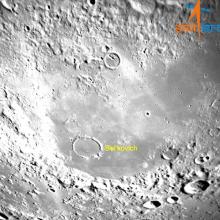Listen to today's episode of StarDate on the web the same day it airs in high-quality streaming audio without any extra ads or announcements. Choose a $8 one-month pass, or listen every day for a year for just $30.
You are here
Moon and Regulus
The Moon slowly closes in on one of the brightest stars in the sky tonight: Regulus, the heart of Leo, the lion. The star stands to the lower left of the Moon as night falls, but closer above the Moon at first light tomorrow.
The Moon passes Regulus once every 27 and a third days. That’s known as the Moon’s “sidereal” period — the time it takes to make one full turn against the background of stars.
But Earth and the Moon are orbiting the Sun, which shifts position against the stars from day to day. Because of that, it takes the Moon about two days longer to catch up to the Sun from one month to the next. Since the Moon’s cycle of phases is determined by its position relative to the Sun, that means the Moon is at a different phase every time it passes Regulus or any other star.
Tonight, for example, the Moon is full. When it sneaks up on Regulus again, in early March, it’ll be a couple of days before full. And in each succeeding month, it’ll be a few days farther from full on each passage. By the time the Moon goes by Regulus in August, it’ll be new, so both the Moon and Regulus will be lost in the Sun’s glare.
And as you watch the Moon early this evening, see if you can notice a faint bit of shading on its face, caused by Earth’s outer shadow, the penumbra. This barely-there eclipse is tough to see. But the Moon itself isn’t — it blazes brightly all night, near the heart of the lion.
Script by Damond Benningfield





